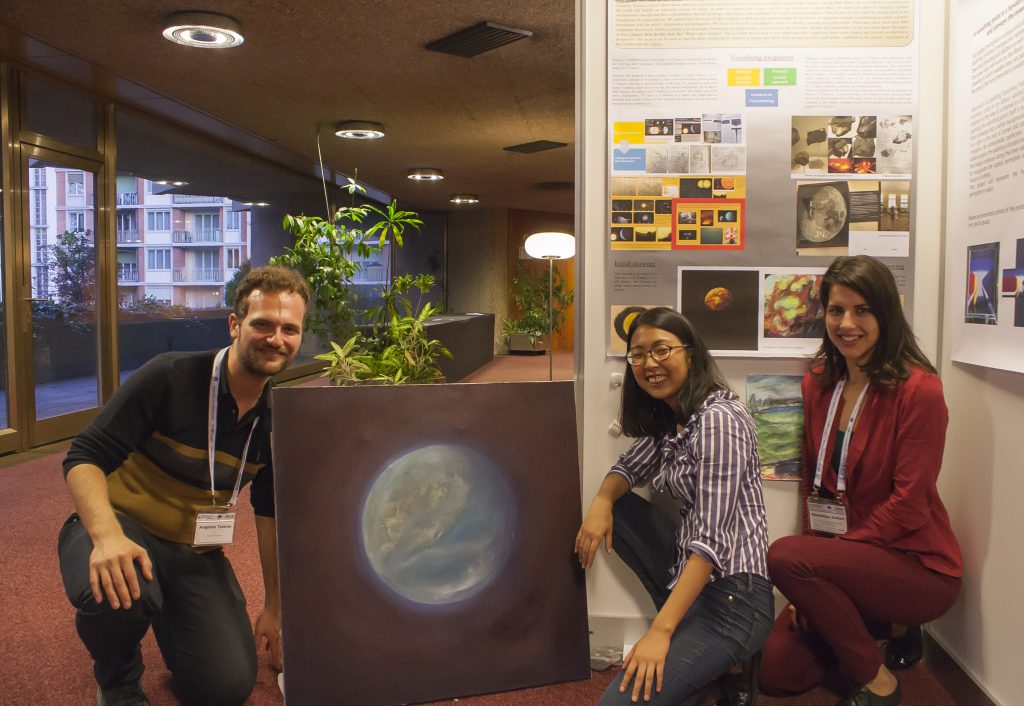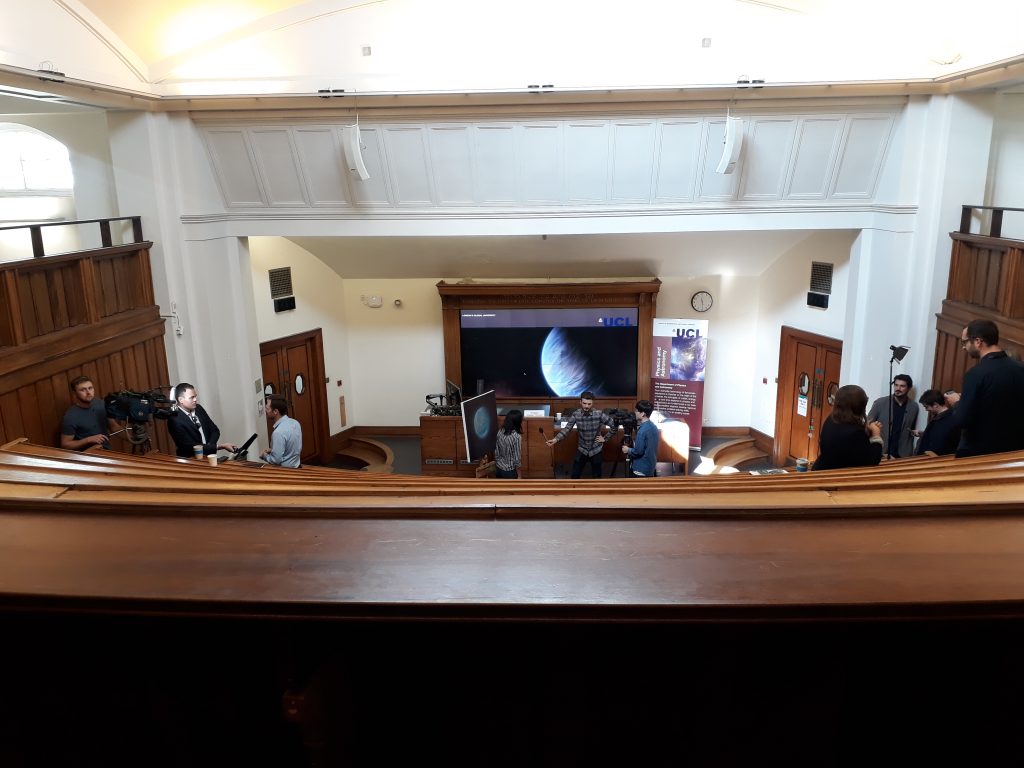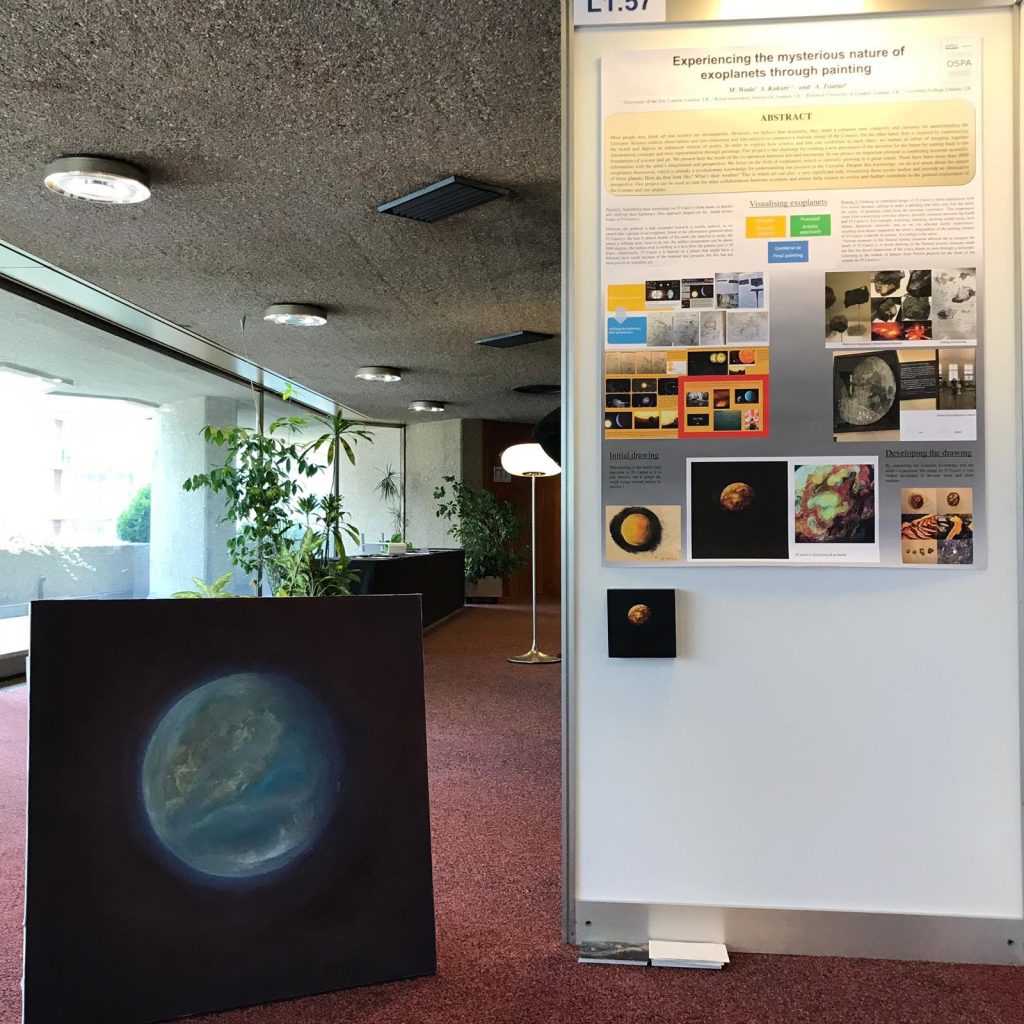Inspiring stories – Painting the unseen
In this EPEC Inspiring Outreach Story, Mai Wada from the University of the Arts London tells us how she has been working with two early career astronomers to enhance our understanding of the universe.
Painting the unseen is an effort to combine scientific data with art to visualise celestial objects, such as exoplanets, that are studied through science but not seen by naked eye. From the early stages of our civilisation, science and art have been two fundamental ingredients of human intelligence that are closely bonded to each other.
Today, our understanding of the Universe has improved tremendously thanks to scientific and technological developments. The question that arises is what can artists and scientists create together in the context of the rapidly changing field of space and astronomy sciences? We started our project in order to address the challenge of creating a unique perspective of the Universe by connecting science and art together.
I am Mai Wada: I am a painter, and for the last year I have been collaborating with two astronomers, Anastasia Kokori and Angelos Tsiaras. Through this collaboration, I have produced a couple of exoplanet paintings. The uniqueness of our project is the nature of our collaboration: two scientists and an artist without any scientific background who didn’t know each other before. We started without a specific methodology or format for how to work together and our image-making process has always been an experiment in itself. We have been working together to create an ideal visualisation of some known exoplanets. The fascinating thing in the project was that the entire process was new to us all.

For myself, the project was an opportunity to learn the latest news and understand more about exoplanets. This experience was entirely new to me and was a great inspiration for my artistic creativity. For the scientists, it was a challenge to present the properties of the exoplanets to me, as these objects cannot be seen by naked eye. They had to help me visualise pure scientific data, observations and calculations.
Methodology
We agreed that our common ground is our curiosity to reveal the mysteries of the world. Despite the fact that art and science have different approaches and processes, we (artists and scientists) are both working towards understanding this world better. Soon, we realised that we had a common aim – to create a unique and new perspective to enhance the human understanding of the Universe.
However, sometimes it seemed to me that art and science were two parallel worlds, with common aims but no interaction with each other. Science approaches the world through a universal perspective, using observations and interpretations. On the other hand, artists use personal experience and feelings to express the world. It took us a long time to understand what science and art can really do together on a practical level and how we could bring these two worlds together. We finally divided the artmaking process into three phases: scientific research, artistic research, and the painting making process summarising both scientific and artistic views.
At the beginning (scientific research phase), I studied exoplanets as a scientist, by interviewing my collaborators. This phase lasted for a long time, as I had to understand a new field from scratch. My collaborators had to explain to me how they are obtaining information about the exoplanets – since we don’t observe them but only the light from their host stars that has been filtered through their atmospheres. I learned what chemical composition can be predicted from the data so far and what predictions we make for the temperature and the weather there.
For the artistic research part, I tried to connect the scientific data with my personal experience and envision the exoplanets. For example, by touching materials around me that could exist on these exoplanets, by watching relevant films, by listening to the sounds of other planets, or even by feeling a similar temperature to the particular planets. This part was flexible and depended on how much data scientists have – or have estimated – about the planets.
For the final process, the painting-making, I made a painting following my creativity after carrying out all this research. In that process, I mostly cared about the material and the technique. I used oil paint for all of them, but the tableau, the size, the way of prime, or thickness of oil, all varied for each exoplanet.
Results

Recently, one painting was presented in a press briefing about the announcement of water vapour in the atmosphere of K2-18b (doi.org/10.1038/s41550-019-0878-9). The briefing was attended by many journalists (including TV and newspapers) who were attracted by the painting and took photos and used it to illustrate their articles and stories. I felt very happy because the panting could bring other people closer to the science of exoplanets. It could help them visualise K2-18b and understand more the discovery that was published that day. In addition, we presented our work in the EPSC-DPS Joint Meeting 2019 and attracted both scientists’ and artists’ attention.

Our experience is that art is quite accessible and we believe that art can act as a bridge between scientists and the public. Scientists and artists were looking at our work and were talking about the nature of exoplanets. We were really satisfied with the result, because this means that the aesthetic visualisation of a scientific object has created an effective context for people to talk about distant planets without any limitation. We plan to continue our project and we hope that our project will reach a wider audience, not only scientists and artists. Our story has just begun.
More paintings and info for Mai Wada here: https://www.maiwada.com
Do you like this story and want more? Browse our archive of EPEC Inspiring Stories and get inspired!

